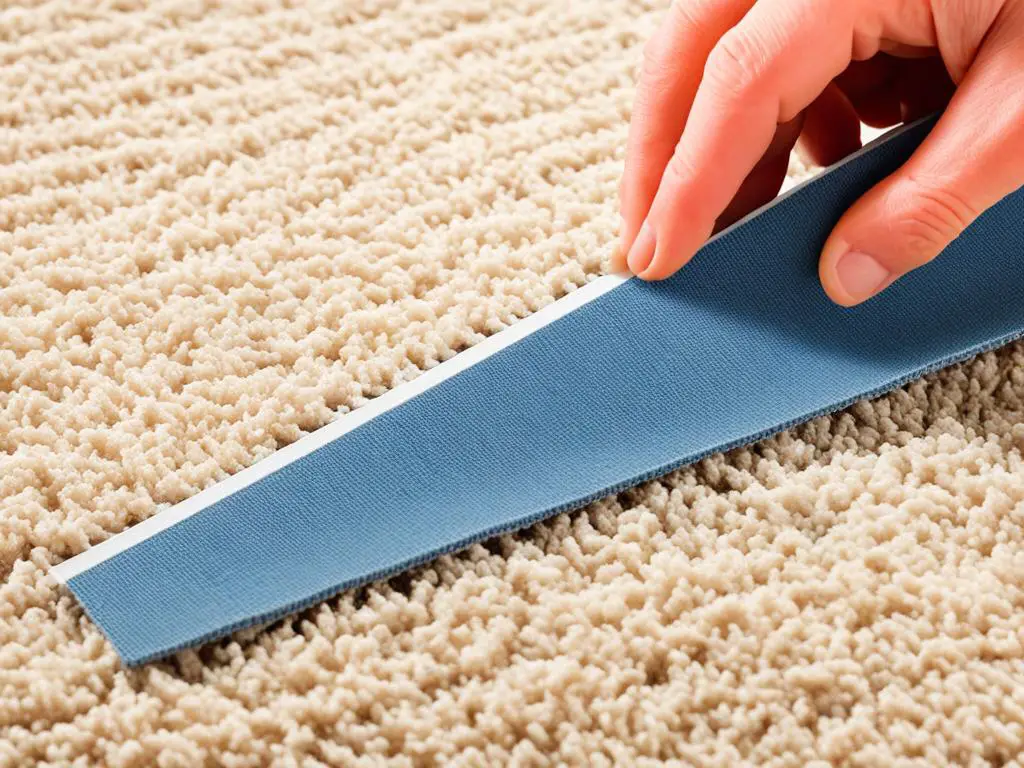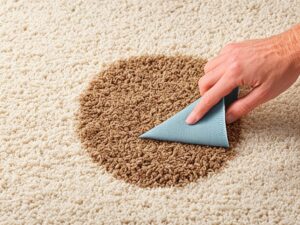Carpet grippers are an integral part of installing carpets, ensuring that they stay in place and maintain a taut appearance. These thin strips of high-grade, resin-bonded plywood feature sharp, angled nails or pins that securely grip the carpet. Installed around the perimeter of the room before fitting the carpet, the pins or nails face towards the wall, providing a secure hold.
Key Takeaways:
- Carpet grippers are essential for keeping carpets securely in place.
- They are thin strips of high-grade plywood with sharp, angled nails or pins.
- Carpet grippers are installed around the perimeter of the room, with pins facing towards the wall.
Now that we know what carpet grippers are, let’s dive deeper into the various types available and how they work.
Different Types of Carpet Grippers
When it comes to carpet installation, choosing the right carpet grippers is crucial for a successful and long-lasting result. There are several types of carpet grippers available, each designed for specific flooring types. Understanding the different options will help you make an informed decision for your carpet gripper installation.
Commercial Carpet Gripper Rods
Commercial carpet gripper rods are specially designed to provide extra grip for stiffer carpets. They feature three rows of pins instead of two, ensuring a secure hold and preventing any movement or slipping. These gripper rods are ideal for high-traffic areas or commercial spaces where carpets need maximum stability.
Standard Wood Carpet Gripper Rods
Standard wood carpet gripper rods are specifically made for wooden subfloors. They are crafted from high-quality wood and feature sharp angled pins that effectively grip onto the carpet. These gripper rods provide a reliable hold and ensure that your carpet stays firmly in place on a wooden surface.
Standard Concrete Carpet Gripper Rods
If you have a concrete or screed subfloor, standard concrete carpet gripper rods are the ideal choice. These gripper rods are designed to withstand the challenges of concrete surfaces and provide a secure hold for your carpet. Their sturdy construction and specialized pins ensure that the carpet remains taut and fixed to the floor.
Standard Dual-Purpose Carpet Gripper Rods
Standard dual-purpose carpet gripper rods are versatile options that can be used on both wooden and concrete subfloors. They offer the convenience of compatibility with different floor types, making them a popular choice for installations where flexibility is required. These gripper rods provide a reliable grip and ensure a secure installation, regardless of the subfloor type.
Short Pin Dual-Purpose Carpet Gripper Rods
Short pin dual-purpose carpet gripper rods are specifically designed for short pile or cord carpets. The shorter pins on these gripper rods provide a secure grip without damaging the carpet fibers. If you have a low-profile carpet, such as Berber or cord, these gripper rods are the perfect choice for a secure and neat installation.
Choosing the right type of carpet gripper rods for your specific flooring type is essential to ensure a successful carpet installation. Consider the characteristics of your carpet and subfloor to determine the most suitable option for your project.
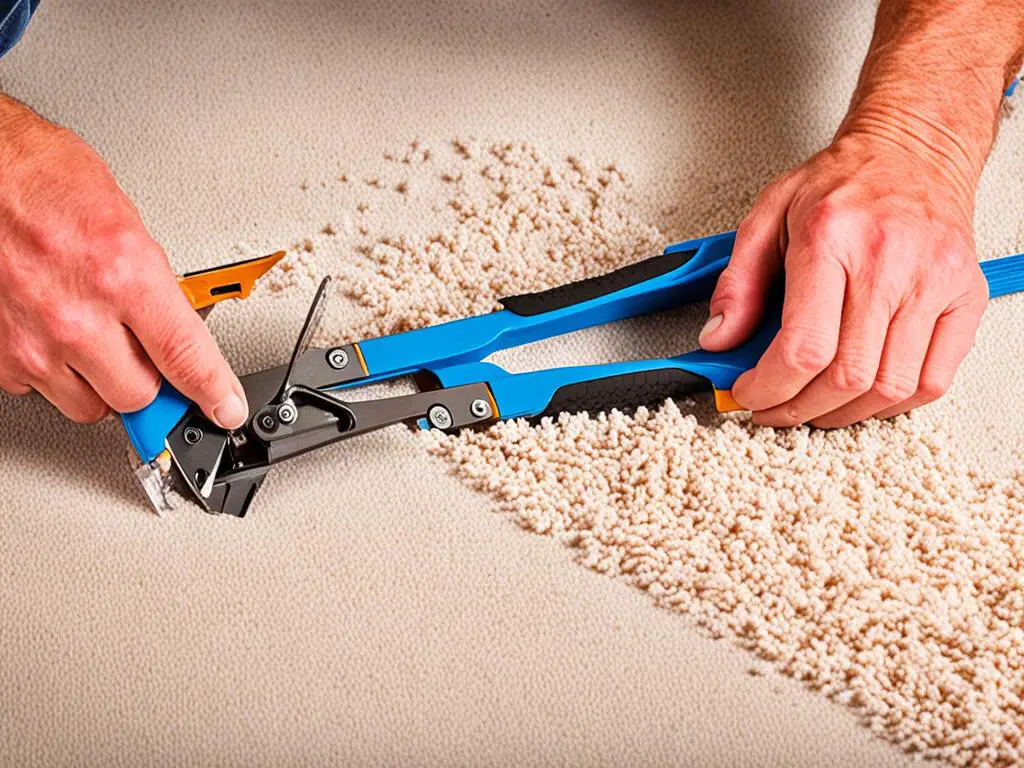
| Carpet Gripper Type | Compatible Subfloor | Features |
|---|---|---|
| Commercial Carpet Gripper Rods | All flooring types | Three rows of pins for extra grip |
| Standard Wood Carpet Gripper Rods | Wooden subfloors | Sharp angled pins for secure hold |
| Standard Concrete Carpet Gripper Rods | Concrete or screed subfloors | Sturdy construction for stability |
| Standard Dual-Purpose Carpet Gripper Rods | Wooden and concrete subfloors | Compatible with different floor types |
| Short Pin Dual-Purpose Carpet Gripper Rods | All flooring types | Designed for short pile or cord carpets |
How to Install Carpet Grippers
Installing carpet grippers is an essential step in ensuring a secure and professional carpet installation. By following these simple steps, you can successfully install carpet grippers in your room:
Select the Appropriate Gripper Type
Before installing carpet grippers, it’s important to choose the right type for your floor. There are different gripper rods available, such as wood gripper rods and concrete gripper rods. Consider the type of subfloor you have and select the gripper rods accordingly.
Cut the Gripper Rods to Size
Once you have chosen the appropriate gripper rods, you’ll need to cut them to the correct size. Use a hacksaw to trim the gripper rods to the desired length. Ensure that you leave a gap between the skirting and the gripper rods to accommodate the carpet.
Position the Grippers
Position the grippers around the perimeter of the room, ensuring that they are placed parallel to the walls. Make sure that the angled nails or pins on the gripper rods face towards the wall. This will hold the carpet in place securely.
Nail Down or Stick the Grippers
There are two methods for securing the grippers to the floor. You can either nail them down by hammering the nails into the floor, or you can stick them down using adhesive. Choose the method that is most suitable for your floor type.
- If using nails, hammer them into the floor at regular intervals along the length of the gripper rods. Ensure that the nails penetrate the subfloor fully to provide a strong grip.
- If using adhesive, apply the adhesive to the back of the gripper rods and press them firmly onto the floor. Follow the manufacturer’s instructions for the adhesive application.
For concrete floors, you may need to drill holes and insert dowel rods before hammering in the nails. This will provide additional support and stability for the gripper rods.
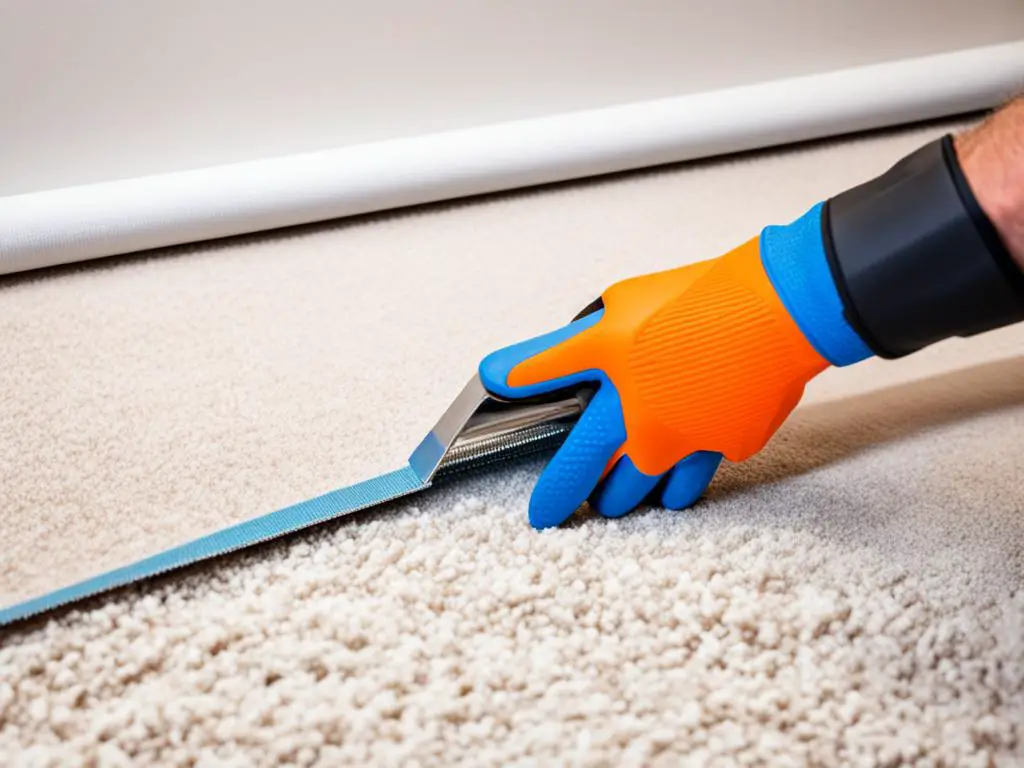
With the carpet grippers properly installed, you are now ready to move on to the next step in the carpet installation process. By following the correct installation techniques, you can ensure a secure and professional finish for your carpets.
Tips for Fitting Carpet Grippers
When it comes to fitting carpet grippers, following a few key tips can ensure a successful installation. Here are some important considerations to keep in mind:
Maintain an even gully width: The gully refers to the space between the gripper strip and the wall. It is crucial to maintain a consistent gully width throughout the installation. Aim for a gully width that is about 60% of the carpet thickness. This will help keep the carpet taut and prevent it from drooping over time.
Securing the gripper rods: To ensure a secure grip, it is important to properly secure each gripper piece. Use at least two angled pins or nails to secure the gripper rods in place. This will prevent them from spinning or turning when you push the carpet edge into the gully. For hard-to-reach areas, consider using a drive bar and heavy hammer to securely fasten the gripper rods.
Avoid extremes: Avoid making the gully width too wide or too narrow. If the gully is too wide, the carpet may lack tension and droop over time. On the other hand, if the gully is too narrow, you won’t be able to tuck the edge of the carpet into the gully properly. Finding the right balance is essential for a neat and professional carpet installation.
By keeping these tips in mind, you can ensure that your carpet grippers are properly fitted, providing a secure and professional finish to your carpet installation.
Here is an example of a well-fitted carpet gripper:
| Gripper Rod | Angle Pins | Gully Width | Securing Method |
|---|---|---|---|
| Standard Wood Carpet Gripper Rods | Angled Pins | 60% of carpet thickness | 2 nails per gripper piece |
Benefits of Using Carpet Grippers
Using carpet grippers has several advantages for a secure and professional carpet installation. Let’s take a closer look at the benefits they offer:
- Secure Carpet Installation: Carpet grippers ensure that your carpet stays in place, preventing slipping or movement. This is especially important in high-traffic areas where carpets are prone to shifting.
- Prevent Slipping: By securely gripping the carpet, these grippers help prevent accidents caused by slipping or tripping on loose carpets. This adds an extra layer of safety to your space.
- Professional Finish: When installed properly, carpet grippers hold the carpet taut, preventing wrinkles or creases. This creates a clean and professional finish, enhancing the overall look of your space.
- Neat Transition: Carpet grippers also assist in creating a seamless transition between the carpet and the skirting board or other types of flooring. This ensures a polished and cohesive appearance throughout the room.
- Easier Carpet Stretching: During the installation process, carpet grippers make it easier to stretch the carpet evenly, resulting in a smoother and more even appearance. This contributes to a more professionally installed carpet.
By utilizing carpet grippers, you can enjoy the benefits of a secure and well-finished carpet installation, while also ensuring safety and preventing any unwelcome slipping or movement. Now, let’s move on to learning how to remove carpet grippers when needed.
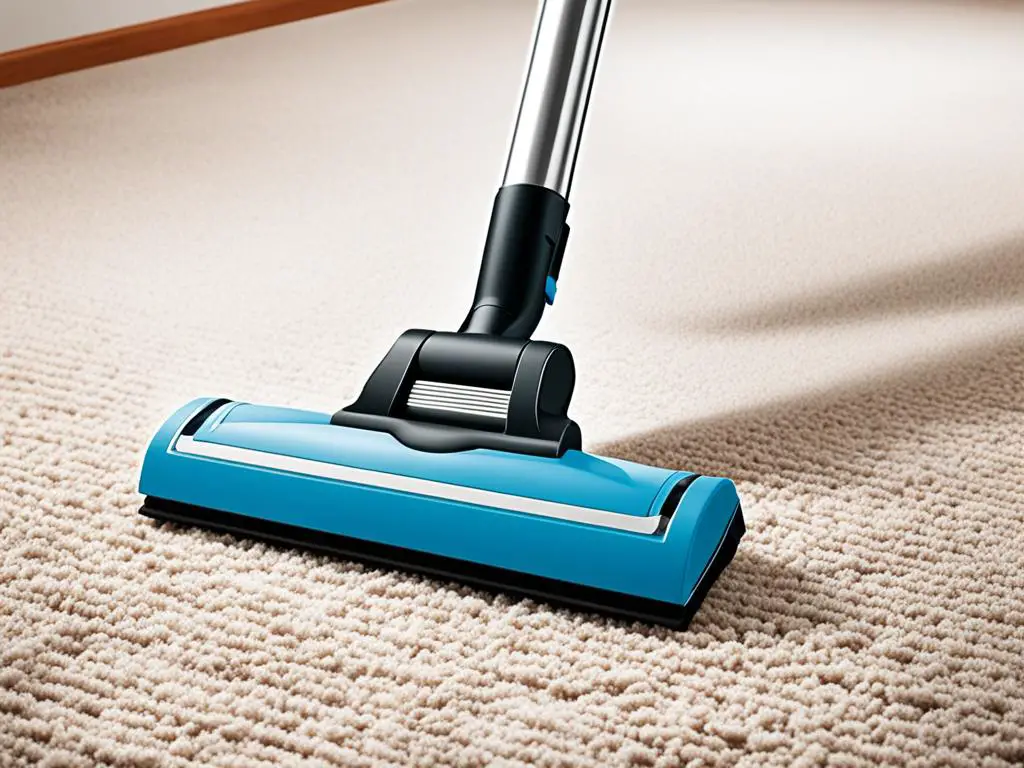
Benefits of Carpet Grippers
| Benefits | Description |
|---|---|
| Secure Carpet Installation | Prevents slipping or movement |
| Prevent Slipping | Enhances safety by keeping carpets in place |
| Professional Finish | Holds the carpet taut, preventing wrinkles or creases |
| Neat Transition | Creates a seamless transition between carpet and other flooring |
| Easier Carpet Stretching | Helps achieve a smoother and more even appearance |
How to Remove Carpet Grippers
If you find yourself needing to replace carpet grippers, it’s important to follow the proper steps to ensure a smooth and safe removal process. Here’s a guide on how to remove carpet grippers:
- First and foremost, ensure your safety by wearing protective goggles and gloves.
- Use a chisel to gently loosen the gripper from the floor. Start at one end and hammer along its length, gradually lifting it off the surface.
- Once the gripper is loosened, you can then proceed to remove the nails or adhesive that secured it in place. This will create space for the new gripper rods.
- Depending on the type of installation, you may need to lever the nails out of the floor or carefully peel away any adhesive residue. Take caution to avoid damaging the floor underneath.
- When removing the grippers, it’s essential to be mindful of any sharp nails or edges to prevent any accidents or injuries.
It is important to note that when installing a new carpet, it’s recommended to use new grippers rather than reusing old ones. Over time, grippers can become weak or damaged, compromising their effectiveness in holding the carpet in place.
By following these steps, you can safely remove carpet grippers and prepare the floor for the installation of new gripper rods.
Testimonial:
“I recently had to replace the carpet in my living room, and the instructions on how to remove the old grippers provided here were immensely helpful. I was able to complete the removal process without any issues or damage to my floor. Thank you!” – Emily Johnson
| Advantages | Disadvantages |
|---|---|
| Smooth and safe removal process | Potential risk of damaging the floor if not done carefully |
| Prepares the floor for new gripper rods | May require additional tools and equipment |
| Ensures a secure and professional carpet installation | Old grippers may have weakened over time |
Conclusion
Carpet grippers play a crucial role in achieving a secure and professional carpet installation. With their different types catering to various flooring surfaces, they offer several benefits that ensure a successful and long-lasting result. By using the best carpet grippers, you can prevent slipping and movement of the carpet, creating a safe and stable surface for daily use.
One of the key advantages of carpet grippers is their ability to keep the carpet taut and free of wrinkles or creases. This not only enhances the appearance of the carpet but also prolongs its lifespan by reducing wear and tear. Additionally, carpet grippers enable a seamless transition between the carpet and other flooring, providing a clean and professional finish.
During the carpet installation process, it is essential to follow the proper instructions for fitting the grippers to ensure a secure and flawless result. Consider the quality and suitability of the carpet grippers for your specific needs, selecting the best option that matches your flooring type. By doing so, you can achieve a secure carpet fitting that guarantees both comfort and longevity.
